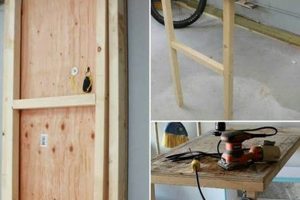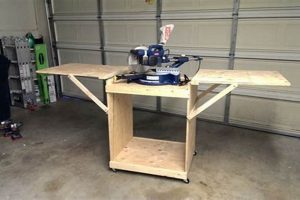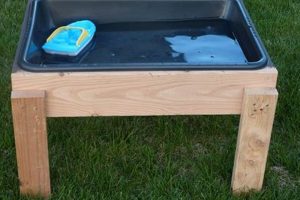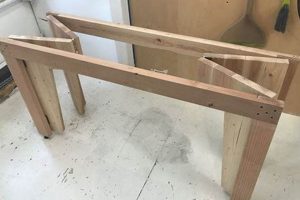A self-constructed kitchen surface, commonly referred to as a butcher block island or a repurposed wooden worktop, offers a durable and aesthetically pleasing addition to a culinary space. Often assembled from individual pieces of hardwood, the finished product provides a robust area suitable for food preparation, dining, or general kitchen tasks. An example includes a reclaimed maple countertop mounted on a repurposed cabinet base, creating a unique and functional island.
The appeal of these customized surfaces lies in their cost-effectiveness, the opportunity for personalization, and the inherent warmth they bring to a kitchen environment. Their construction allows for precise size and shape adjustments to perfectly fit the available space. Historically, similar designs provided essential working areas in butcher shops and professional kitchens, valued for their resilience and sanitary properties.
The subsequent sections will elaborate on materials selection, construction techniques, finishing processes, and design considerations relevant to creating a successful and lasting example of such a build. These encompass various aspects, from sourcing the appropriate wood and understanding grain orientation to selecting suitable adhesives and applying food-safe coatings.
Tips for Creating a Durable Kitchen Work Surface
Constructing a reliable and aesthetically pleasing culinary workspace demands careful planning and execution. The following suggestions provide insights into maximizing the lifespan and functionality of a self-made wooden food preparation area.
Tip 1: Wood Selection: Choose hardwoods such as maple, walnut, or cherry for their density and resistance to wear. Softwoods like pine are unsuitable due to their susceptibility to dents and scratches. Ensure the wood is kiln-dried to prevent warping or cracking after assembly.
Tip 2: Grain Orientation: Orient the wood grain vertically (end grain) for maximum durability, particularly if the surface will be used for heavy chopping. Edge grain orientation offers a balance between durability and aesthetics, while face grain is the least durable and most prone to knife marks.
Tip 3: Adhesive Choice: Use a waterproof and food-safe wood glue, such as Titebond III, during assembly. Ensure the glue is evenly distributed and clamped securely to create strong bonds between the individual wood pieces. Insufficient clamping can lead to weak joints and eventual separation.
Tip 4: Surface Preparation: Thoroughly sand the assembled surface using progressively finer grits of sandpaper, starting with 80-grit and finishing with 220-grit. This creates a smooth, even surface that is ready for finishing. Uneven sanding can result in an uneven finish.
Tip 5: Food-Safe Finishes: Apply a food-safe finish, such as mineral oil or beeswax. These finishes penetrate the wood, protecting it from moisture and preventing bacterial growth. Avoid using varnishes or polyurethane, as they are not food-safe and can chip or flake over time.
Tip 6: Regular Maintenance: Apply mineral oil regularly, especially after cleaning. This replenishes the wood’s natural oils and prevents it from drying out and cracking. Neglecting maintenance can significantly shorten the lifespan of the surface.
Tip 7: Proper Cleaning: Clean the surface with mild soap and water, and avoid harsh chemicals or abrasive cleaners. Sanitize the surface with a diluted bleach solution (1 tablespoon of bleach per gallon of water) if necessary. Thorough cleaning and sanitization are crucial to prevent the spread of bacteria.
These recommendations ensure a sturdy, hygienic, and visually appealing structure, suitable for a variety of culinary tasks and capable of withstanding daily use for years to come.
The final segment will address advanced design concepts and explore alternative construction methods for those seeking a more sophisticated project.
1. Material Selection
Material selection directly determines the longevity, functionality, and aesthetic properties of a self-constructed culinary workspace. The inherent characteristics of chosen woods influence the structure’s resistance to impact, moisture absorption, and susceptibility to bacterial contamination. For instance, using a high-density hardwood such as maple results in a substantially more durable surface compared to employing a softwood like pine. The denser structure of maple resists knife marks and water penetration, contributing to both a longer lifespan and improved hygiene. Conversely, the softer nature of pine renders it prone to scratching and swelling, compromising its utility as a reliable food preparation area. This selection is therefore a foundational decision point in the creation of a quality work surface.
Beyond durability, the aesthetic qualities of the wood influence the overall appearance. Cherry, walnut, and maple, for example, offer distinct grain patterns and color variations, allowing for customization to suit individual design preferences. Utilizing reclaimed wood, such as old-growth oak, introduces a unique history and character to the piece. However, reclaimed material necessitates careful inspection to ensure it is free from contaminants like lead paint or embedded nails, underscoring the need for informed decision-making throughout the construction process. The type of wood also affects the finishing process; different woods absorb finishes at varying rates, requiring adjustments to the application technique to achieve a uniform and protective coating.
In conclusion, the choice of materials significantly impacts the structural integrity, hygienic properties, and visual appeal of a handcrafted wooden surface. Careful consideration of density, grain pattern, potential contaminants, and finish compatibility is essential. The selection process presents both opportunities for customization and potential pitfalls requiring careful evaluation to ensure the creation of a functional, durable, and aesthetically pleasing structure.
2. Dimensional Accuracy
Dimensional accuracy, defined as the degree to which measured dimensions conform to specified or designed dimensions, is a foundational element in the successful fabrication of a sturdy and functional self-made wooden surface. Deviations from intended measurements can compromise structural integrity, aesthetic appeal, and the overall utility of the finished piece. This adherence to precise measurements is therefore paramount throughout the entire construction process.
- Component Alignment and Stability
Precise dimensional accuracy ensures that individual wooden components align seamlessly during assembly. When pieces are cut to the specified dimensions, joints fit snugly, providing maximum surface contact for adhesives and mechanical fasteners. Misalignment resulting from inaccurate cuts creates weak points, reduces structural stability, and may lead to premature failure of the constructed surface under load. Examples include accurately sized tenons fitting precisely into mortises, and uniformly dimensioned boards creating a level surface plane.
- Surface Flatness and Levelness
A food preparation area requires a flat and level surface for efficient and safe use. Dimensional inaccuracies in individual components translate into an uneven or warped final product. These irregularities can impede food preparation tasks, increase the risk of accidents involving knives or other tools, and detract from the aesthetic appearance. Consistent material thickness and proper leveling techniques during assembly are critical to achieving a truly flat surface.
- Consistent Joint Strength
The strength of joints, whether adhesive or mechanical, is directly correlated with the accuracy of the mating surfaces. Gaps or inconsistencies resulting from dimensional errors weaken the bond, reducing the overall durability of the surface. Accurate mortise and tenon joints, precisely fitted dovetails, or properly sized dowel joints ensure optimal load distribution and prevent premature failure. Poor joint construction due to dimensional inaccuracies can lead to structural instability and separation of components under stress.
- Aesthetic Harmony and Visual Appeal
Beyond structural considerations, dimensional accuracy significantly impacts the visual appeal of the finished product. Precisely cut and assembled components create clean lines, uniform surfaces, and an overall sense of quality craftsmanship. Visible gaps, misaligned edges, or inconsistent thicknesses detract from the aesthetic harmony and diminish the perceived value of the handcrafted surface. Achieving visual appeal requires meticulous attention to detail and a commitment to dimensional accuracy throughout the construction process.
The cumulative effect of accurate measurements extends beyond individual components, ultimately defining the performance and longevity of the finished woodworking project. Implementing best practices in measurement, cutting, and assembly techniques safeguards against structural deficiencies, ensures functional utility, and enhances the overall aesthetic value of the surface. Prioritizing dimensional accuracy is a fundamental principle in the pursuit of a high-quality, self-made wooden food preparation area.
3. Joint Strength
The structural integrity of a self-constructed wooden surface, designed for culinary use, hinges critically upon the strength of its joints. Joint strength, in this context, refers to the capacity of assembled connections between individual wood components to resist separation or deformation under load. Inadequate joint strength directly compromises the surface’s ability to withstand the forces exerted during food preparation activities, such as chopping, kneading, or placing heavy objects. A failure in a joint can lead to surface instability, unevenness, or complete structural collapse. The selection of appropriate jointing techniques, coupled with precise execution, is therefore paramount in creating a durable and reliable surface.
Various jointing methods offer differing degrees of strength and complexity. Mortise and tenon joints, for instance, provide exceptional resistance to both tensile and shear forces, making them suitable for high-stress applications. Dowel joints, while simpler to execute, offer moderate strength and are appropriate for less demanding applications. Butt joints, reinforced with screws or adhesive, represent the weakest option and are generally unsuitable for structural components within a food preparation area. The choice of jointing technique should be determined by the anticipated load and usage patterns. Moreover, the proper application of adhesive is essential. A high-quality wood glue, specifically formulated for structural applications and food safety, must be applied evenly and allowed to cure fully to achieve maximum bond strength. Clamping during the curing process ensures intimate contact between the mating surfaces, optimizing the adhesive’s effectiveness.
In summary, joint strength is an indispensable element in the construction of a long-lasting and functional wooden surface. Neglecting this aspect undermines the overall structural integrity and limits the surface’s ability to withstand the rigors of daily use. Prioritizing robust jointing techniques, selecting appropriate adhesives, and adhering to best practices in assembly are critical steps in creating a reliable and enduring culinary workspace.
4. Surface Finishing
Surface finishing constitutes a critical phase in the creation of a self-made wooden surface designed for culinary purposes. The selection and application of a suitable finish directly influence the durability, hygiene, and aesthetic characteristics of the completed piece. Without appropriate treatment, the wood remains vulnerable to moisture absorption, bacterial contamination, and physical damage, thereby compromising its longevity and safety for food preparation. A properly applied finish, conversely, provides a protective barrier, enhancing the surface’s resistance to wear, facilitating cleaning, and augmenting its visual appeal.
The selection of finishing materials necessitates careful consideration of food safety and the intended use of the surface. Penetrating oil finishes, such as mineral oil or tung oil, are commonly employed due to their non-toxic nature and ability to seep into the wood fibers, creating a water-resistant barrier. However, these finishes require periodic reapplication to maintain their protective properties. Film-forming finishes, such as varnish or polyurethane, offer enhanced durability and water resistance but may not be considered food-safe in their cured state. Certain specialized epoxy resins, formulated for contact with food, can provide a durable and impermeable surface but demand precise application techniques to ensure uniform coverage and prevent the release of harmful chemicals. Improper finishing can lead to the absorption of liquids, fostering bacterial growth, warping of the wood, or the leaching of toxic substances into food. For instance, a wooden surface left untreated will readily absorb spilled liquids, creating a breeding ground for bacteria like E. coli and Salmonella, posing a significant health risk. A butcher block sealed with a food-safe mineral oil, on the other hand, will repel liquids, minimizing bacterial growth and simplifying cleaning.
In summary, surface finishing is not merely an aesthetic consideration but a fundamental aspect of constructing a safe, durable, and functional wooden surface for food preparation. Careful selection of food-safe materials and diligent application are essential to ensure the longevity, hygiene, and overall utility of the finished product. Failure to address this crucial step negates the benefits of meticulous material selection and precise joinery, rendering the completed surface unsuitable for its intended purpose.
5. Base Construction
The structural integrity and functionality of a self-constructed wooden culinary surface are inextricably linked to the design and execution of its base. This foundational element provides support, stability, and, in many instances, integrated storage solutions. The base construction, therefore, is not merely a secondary consideration but a critical component that dictates the overall utility and longevity of the finished surface.
- Structural Support and Load Distribution
The primary function of the base is to provide adequate support for the weight of the wooden surface and any additional load placed upon it during use. The design must account for the dimensions of the surface, the density of the chosen wood, and the anticipated weight of culinary equipment and materials. A poorly constructed base can result in sagging, instability, or even collapse. For instance, a base constructed from thin, unsupported legs may buckle under the weight of a thick maple butcher block and heavy pots. Conversely, a robust base with properly distributed weight can withstand significant loads, ensuring years of reliable service.
- Stability and Prevention of Movement
Beyond supporting weight, the base must provide stability to prevent unwanted movement during food preparation. A stable base minimizes the risk of accidents and ensures a safe and efficient working environment. Design elements such as wide-set legs, cross bracing, and adjustable feet contribute to enhanced stability on uneven surfaces. An example of instability would be a tall, narrow base that is easily tipped over when someone leans against the culinary surface. A well-designed base incorporates features that counteract these forces, providing a secure and stationary work area.
- Material Selection and Durability
The choice of materials for the base mirrors the importance of material selection for the surface itself. Hardwoods such as oak or maple offer superior strength and durability compared to softwoods like pine. Metal framing can also be incorporated to provide additional support and a modern aesthetic. Regardless of the material, the base must be resistant to moisture, pests, and physical damage. A base constructed from untreated softwood, for example, may be susceptible to rot and insect infestation, compromising its structural integrity over time. Selecting durable and weather-resistant materials ensures a longer lifespan for the entire structure.
- Integration of Storage Solutions
In addition to structural considerations, the base often provides an opportunity to integrate storage solutions into the design. Shelves, drawers, and cabinets can be incorporated to maximize functionality and minimize clutter in the kitchen. The design of these storage components must be carefully integrated with the overall structure to maintain stability and prevent interference with the primary function of the work surface. A base with poorly designed drawers, for example, may compromise the structural integrity of the table, while a well-integrated storage solution enhances both the utility and aesthetic appeal.
The integration of structural support, stability features, durable materials, and thoughtful storage solutions underscores the critical role of the base in the successful creation of a self-made wooden food preparation area. Careful consideration of these elements ensures a robust, functional, and aesthetically pleasing addition to the culinary workspace. Neglecting the base design can undermine the investment in a high-quality wooden surface, resulting in a structure that is both unsafe and short-lived.
6. Ergonomic Height
Ergonomic height, referring to the optimal working surface elevation designed to minimize physical strain and maximize efficiency, is a crucial consideration in the construction of a self-made culinary workspace. A chopping block table that disregards ergonomic principles can lead to discomfort, fatigue, and potential musculoskeletal disorders over prolonged use. The height of the table directly impacts posture, arm and shoulder positioning, and the force required for various food preparation tasks. A surface that is too low necessitates excessive bending, straining the back muscles. Conversely, a surface that is too high forces the shoulders to elevate, causing tension in the neck and upper back. Real-world examples demonstrate this; chefs who work on improperly sized surfaces report higher instances of back pain and repetitive strain injuries compared to those utilizing ergonomically designed workstations. An appropriately sized DIY chopping block table therefore mitigates these risks, promoting a safer and more comfortable cooking experience.
The ideal height for a culinary surface is generally determined by the user’s stature. A commonly cited guideline suggests a height that allows the user to work with their elbows bent at a 90-degree angle, with their forearms parallel to the ground. However, individual preferences and specific tasks may necessitate adjustments. For example, kneading dough often benefits from a slightly lower surface, allowing for greater leverage and force application. Precise measurement and customization are therefore paramount in achieving optimal ergonomic benefits. Incorporating adjustable legs or a variable-height base into the construction can accommodate multiple users or facilitate different types of food preparation. This adaptability enhances the overall versatility and usability of the handcrafted surface.
In summary, ergonomic height is an indispensable element in the creation of a comfortable and sustainable culinary workspace. A self-made chopping block table that prioritizes ergonomic principles promotes proper posture, reduces physical strain, and enhances overall efficiency. By carefully considering individual needs and incorporating adjustable features, the resulting structure contributes to a safer and more enjoyable cooking experience. Overlooking this aspect compromises the long-term usability and potentially introduces health risks, underscoring the importance of integrating ergonomic considerations throughout the design and construction process.
7. Food Safety
The construction and maintenance of a self-made wooden surface intended for culinary use necessitates a comprehensive understanding of food safety principles. The direct contact between food and the table surface introduces potential hazards if appropriate precautions are not implemented. The porous nature of wood, if left untreated or improperly sealed, can harbor bacteria, leading to cross-contamination and potential foodborne illnesses. The selection of food-safe materials, the implementation of proper sanitation practices, and the regular maintenance of the surface are therefore crucial components in ensuring the safety of food prepared on such structures. For example, a butcher block constructed from reclaimed wood with residual lead paint poses a significant health risk, underscoring the importance of rigorous material inspection.
Furthermore, the choice of wood and the application of appropriate finishes directly influence the surface’s ability to resist bacterial growth and moisture penetration. Hardwoods such as maple or beech, known for their density and tight grain, are generally preferred over softwoods like pine, which are more susceptible to harboring microorganisms. Food-grade mineral oil or beeswax finishes provide a protective barrier against moisture, facilitating cleaning and inhibiting bacterial proliferation. Regular sanitization using diluted bleach solutions or food-safe disinfectants is essential for maintaining a hygienic surface. This proactive approach to sanitation minimizes the risk of cross-contamination and prevents the spread of harmful pathogens during food preparation. A failure to adhere to these practices can lead to outbreaks of foodborne illnesses, highlighting the practical significance of prioritizing food safety within the context of self-constructed culinary surfaces.
In summary, the creation and upkeep of a do-it-yourself chopping block table demand a meticulous focus on food safety protocols. The selection of appropriate materials, the implementation of proper finishing techniques, and the adherence to rigorous sanitation practices are essential for mitigating the risks of bacterial contamination and ensuring the safe preparation of food. A failure to prioritize food safety undermines the intended purpose of the structure, potentially jeopardizing the health of individuals who consume food prepared on its surface. The long-term success of such a project is contingent upon a commitment to maintaining a safe and hygienic culinary environment.
Frequently Asked Questions
This section addresses common inquiries regarding the construction, maintenance, and safety aspects of self-made wooden surfaces intended for food preparation.
Question 1: What type of wood is most suitable for a culinary work surface?
Hardwoods such as maple, walnut, cherry, or beech are generally preferred due to their density, durability, and resistance to bacterial growth. Softwoods like pine are less suitable due to their susceptibility to dents, scratches, and moisture absorption.
Question 2: Is it necessary to use food-safe adhesives during construction?
Yes. Adhesives that come into direct or indirect contact with food must be certified as food-safe. Polyurethane-based adhesives formulated for wood are often recommended, provided they are fully cured before the surface is used for food preparation.
Question 3: How should a culinary wood surface be finished to ensure food safety?
Penetrating oil finishes, such as mineral oil or tung oil, are commonly employed. These oils soak into the wood fibers, creating a water-resistant barrier. Regular reapplication is necessary to maintain the protective properties. Film-forming finishes, like polyurethane, are generally not recommended for direct food contact surfaces.
Question 4: What is the recommended cleaning procedure for a wooden culinary surface?
Clean the surface with mild soap and water after each use. Avoid harsh chemicals or abrasive cleaners. A diluted bleach solution (1 tablespoon of bleach per gallon of water) can be used for sanitization purposes. Ensure the surface is thoroughly dried after cleaning.
Question 5: How can the risk of bacterial contamination be minimized?
Select a dense hardwood, apply a food-safe finish, clean and sanitize the surface regularly, and avoid using the surface for cutting raw meat or poultry. Employ separate cutting boards for different types of food to prevent cross-contamination.
Question 6: What is the expected lifespan of a well-maintained culinary wood surface?
With proper care and maintenance, a high-quality culinary wood surface can last for many years. Regular oiling, prompt cleaning, and avoidance of excessive moisture exposure will significantly extend its lifespan.
The information provided in this FAQ section serves as a general guide. Consult with experienced woodworkers or culinary professionals for specific recommendations tailored to individual project requirements.
The subsequent section will explore advanced design concepts for specialized food preparation surfaces.
Conclusion
This exploration of the “diy chopping block table” has underscored the multifaceted considerations necessary for its successful creation and enduring utility. From the critical selection of appropriate hardwoods and food-safe adhesives to the precise execution of joinery and the diligent application of protective finishes, each stage demands careful attention to detail. The understanding of ergonomic principles and rigorous adherence to food safety protocols are paramount to ensure a safe, functional, and aesthetically pleasing addition to any culinary space.
The construction of such a structure represents a significant investment of time and resources. Its value, however, extends beyond mere functionality. A well-crafted, properly maintained “diy chopping block table” serves not only as a durable food preparation area but also as a testament to craftsmanship and a potential heirloom, embodying a commitment to quality and longevity. Therefore, a thorough understanding of the principles outlined herein is essential for any individual embarking on this endeavor, ensuring a lasting and rewarding outcome.







